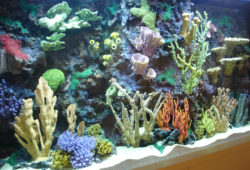Shrimp for the Marine Aquarium
In the article I’m going to tell you about Shrimp for the Marine Aquarium. There are many shrimp from which to choose for a saltwater aquarium. Here is an easy way to decide which ornamental shrimp are right for your tank.

It is useful to sort shrimp for the marine aquarium into several categories that make selection a little easier for the beginning aquarist. In this article, the following categories of shrimp for the marine aquarium are discussed:
- Symbiotic Shrimp
- Maintenance Shrimp
- Shrimp to Avoid
Contents
Symbiotic Shrimp
These shrimp are amongst the most interesting invertebrates to keep in a marine aquarium. Some of the symbiotic relationships rival that of the more popularized clownfish-anemone pairing in many aquarists’ opinions. It’s important to understand that there are several different types of symbiotic relationships. They are:
- Mutualistic
- Commensal
- Parasitic
A symbiotic relationship may be said to be mutualistic when both organisms benefit from the relationship. The relationship is commensal when one organism benefits and the other neither benefits nor suffers. It can be called parasitic when one organism benefits at the expense of the other (and, for obvious reasons, we won’t be discussing these).
Amongst the mutualistic relationships, the ones between shrimp and shrimp-gobies are fascinating and can easily be the centerpiece of a small marine aquarium. Pistol shrimp, from the genus Alpheus, will readily pair up with shrimp gobies from the genera Amblyeleotris and Stonogobiops. The pistol shrimp digs a burrow, and the shrimp goby acts as the nearly blind shrimp’s eyes. When the pistol shrimp ventures out to feed, it stays in constant contact with its goby. One of the most popular shrimp gobies is the Yasha Hasa Shrimp Goby (Stonogobiops yashia), especially when paired with a Randalls Pistol Shrimp (Alpheus randalli). There is some debate about whether this is really a commensal relationship, but that discussion is beyond the scope of this article.
In terms of commensal relationships, so-called sexy shrimp (Thor amboinensis) are frequently found living in both corals and anemones in the wild, and they will readily do the same in the aquarium. The sexy shrimp, which is very small, benefits from the protection of the anemone’s stinging tentacles or from the stinging tentacles of large-polyped stony coral such as those from the genus Euphyillia, like Anchor Coral (Euphyllia ancora). The shrimp also benefits by feeding on food the anemone catches (or sometimes on the anemone’s tentacles themselves, although this does not seem to hurt the anemone).
Maintenance Shrimp
There are many species of shrimp that perform valuable maintenance functions in the tank. In addition to being beneficial to the health of the tank (and your livestock), many of these shrimp are also attractive and add interest to a reef tank. There are really two primary categories of maintenance shrimp. They are:
- Cleaner Shrimp
- Clean-up Crew Shrimp
Cleaner Shrimp
Cleaner shrimp are amazing invertebrates that will astound both you and anyone who has the opportunity to observe them performing their cleaning function. Cleaner shrimp, such as the Scarlet Cleaner Shrimp (Lysmata amboinensis), will actually set-up cleaning stations and clean parasites off your fish. There is nothing quite like seeing a cleaner shrimp hitching a ride on a Yellow Tang (Zebrasoma flaviscens) while picking parasites and other small organisms off the fish.
Clean-Up Crew Shrimp
While also technically a cleaner shrimp, the common Peppermint Shrimp (Lysmata wurdemanni) often neglects its role as a cleaner shrimp in the aquarium, but it does an excellent job of cleaning up detritus after dark. It also is somewhat famous for targeting Aiptaisia—a small pest anemone that can take over a tank. Peppermint Shrimp are nocturnal, so you may not see them during the day, although they are often visible inside caves.
Shrimp to Avoid
Mantis Shrimp from the genera Gonodactylaceus and Odontodactylus are frequently seen in the hobby, and, while very intelligent and beautiful, they are best left to the species-specific tank. Mantis shrimp can damage the aquarium (especially if it’s glass), its tankmates and you. Unless you know what you’re getting into—steer clear of these shrimp.



